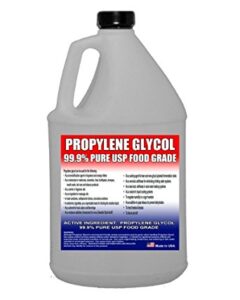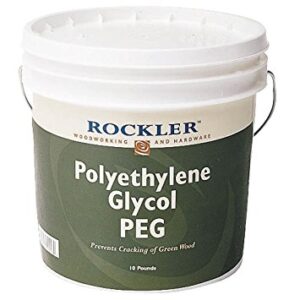 Readers of my blog have no doubt noticed that I’ve focused a lot on glycol-based molecules recently. My expanding allergic symptoms to those particular chemicals have prompted me to have to learn a lot more about them, and this is the result. Rest assured that there will be more areas of focus than just propylene glycol once again, soon.
Readers of my blog have no doubt noticed that I’ve focused a lot on glycol-based molecules recently. My expanding allergic symptoms to those particular chemicals have prompted me to have to learn a lot more about them, and this is the result. Rest assured that there will be more areas of focus than just propylene glycol once again, soon.
I have read so much about propylene glycol and polyethylene glycol recently, much of it no doubt copied from one website to another. Once an idea is stated as fact once, it’s hard to stop that idea from spreading. I have read everything from “propylene glycol is the most dangerous and awful thing you could possibly consume” to “propylene glycol is pretty safe.” Obviously those can’t both be true – can they? I decided today to correct some myths I’ve read about glycol-based molecules.
- Propylene glycol (PG) is not a mineral oil. It is a sugar alcohol. Yes, that also makes it a carbohydrate, as sugars are carbohydrates. It is synthesized from organic (carbon-based), petroleum-based chemicals.
- PG is not the chemical that people traditionally associate with antifreeze, although it is used as antifreeze now. Antifreeze just means a substance that prevents another from becoming a solid when it is exposed to low temperatures. That is, propylene glycol lowers the temperature at which water freezes. Most people remember the danger that toxic antifreeze posed to pets when it leaked from vehicles. That was ethylene glycol. Many countries have switched to propylene glycol now, which is considered much safer. Safer. Not safe. Ethylene/polyethylene glycol is considered at least mildly to moderately toxic (opinions seem to vary). Propylene glycol is not considered toxic in small quantities, though large doses can cause acute toxicity and organ damage. Definition of “toxic”: “Containing or being poisonous material especially when capable of causing death or serious debilitation.” (Merriam-Webster)
 Propylene glycol as a chemical is used as a humectant (helping to attract water), solvent, carrier, thickening agent, sweetener, antifreeze, ingredient/reactant in producing other chemicals, heat carrier (for heat exchangers), preservative, anti-foaming agent, and absorption enhancer. Polyethylene glycol is used as a humectant, laxative, stabilizer, bulking agent/filler, controlled release extender, heat transfer fluid, chemical reactant/ingredient for the production of other chemicals, emulsifier, solvent, anti-foaming agent, insulator, binding agent, and preservative.
Propylene glycol as a chemical is used as a humectant (helping to attract water), solvent, carrier, thickening agent, sweetener, antifreeze, ingredient/reactant in producing other chemicals, heat carrier (for heat exchangers), preservative, anti-foaming agent, and absorption enhancer. Polyethylene glycol is used as a humectant, laxative, stabilizer, bulking agent/filler, controlled release extender, heat transfer fluid, chemical reactant/ingredient for the production of other chemicals, emulsifier, solvent, anti-foaming agent, insulator, binding agent, and preservative.- In vitro (in a petri dish), PG has been found to mutate cells. This has not been proven in typical recommended dosages in vivo (in live bodies). The FDA considers it “generally recognized as safe” (GRAS), making it possible for companies to use in in topical, injected, and food applications. This does not guarantee its safety, and allergic reactions can still occur. It does, however, mean that propylene glycol is allowed to be used in almost everything in your world. Though limits of usage do exist, its ubiquitous nature means that daily contact/ingestion of propylene glycol is likely a lot higher than has been calculated for single exposures.
- Some PG-allergic people experience reactions to glycerin/glycerol as well. Glycerin is another sugar alcohol and is indeed a potential cross-reactor, as its molecule is shaped very similarly to PG. This does not mean that everyone who is allergic to PG will react to glycerin. Some people find that vegetable-sourced glycerin is less reactive for them than synthetic-based glycerin.
- One of the ingredients used to make PG is propylene/ethylene oxide. While ethylene oxide and propylene oxide present their own dangers, they are NOT cross-reactors because their molecular structure is completely different. There are two ways to look at this.
- First, if a chemical was used in the creation of a second chemical, the second chemical will contain traces of the first chemical, since no reaction or separation process is 100%. Thus if you’re allergic to the first chemical you will likely be allergic to the second in some degree. On the other hand, the chemical ingredients added to a reaction to make a different chemical are not the same as the chemical they make. Thus just because you are allergic to the end product does not make you allergic to the ingredients used to make it.


- Another way to think about it: You can be allergic to eggs and thus be allergic to the mayonnaise made from them, but being allergic to mayonnaise does not automatically make you allergic to oil, vinegar, and eggs. The difference is that in cooking it is likely that you would be allergic to one of the starting ingredients, since the final product still contains all three ingredients in only slightly altered form. In a large chunk of industrial chemistry, by comparison, there is a possibility that the ingredients can create something that has none of the properties or molecular structure of the original ingredients. Thus you can be allergic to the product without being allergic to any of the chemicals used to make it.This doesn’t mean that ethylene oxide or propylene oxide are healthy chemicals (evidence: [OSHA – Ethyleneoxide][Sciencelab – MSDS] suggests they are not), but being allergic to PG or PEG does not make you allergic to ethylene oxide or propylene oxide. Also, just because the words “ethylene” or “propylene” are in the names of two chemicals this does not mean that the two chemicals are related in any meaningful way.
- First, if a chemical was used in the creation of a second chemical, the second chemical will contain traces of the first chemical, since no reaction or separation process is 100%. Thus if you’re allergic to the first chemical you will likely be allergic to the second in some degree. On the other hand, the chemical ingredients added to a reaction to make a different chemical are not the same as the chemical they make. Thus just because you are allergic to the end product does not make you allergic to the ingredients used to make it.
- Feeding animals PG does not mean that their meat will contain PG. PG metabolizes quickly in the body of most mammals, meaning that it is converted to other products and used as those other chemicals or excreted. In most cases it should not build up in meat. This does not mean that the animal’s excretions are 100% PG-free (milk, eggs, etc.). I will explore this in further detail in the future. In addition, meat processing plants have been said to wash or inject meat with propylene-glycol-containing compounds to retard bacterial growth, but I have not found sufficient references to confirm this, although this one seems to allow for that possibility.
Understanding what propylene glycol and polyethylene glycol are and aren’t is the first step in beginning to understand how to avoid them. What myths about propylene and polyethylene glycol have you busted? Comment below.

Thank you for clarifying some of the myths surrounding PG/PEG. I believe what you’re saying in #6 is that PG/PEG allergy sufferers may not have a problem with propylene oxide (which is used to make PG) or ethylene oxide (which is used to make PEG) because these ingredients are molecularly different from the end products of PG and PEG—That the chemical ingredients added to a reaction end up making a DIFFERENT chemical altogether. Because of the ubiquitous nature of PG/PEG and their many derivatives/synonyms, however, it’s so difficult to feel safe around many of the chemicals used in medications and processed foods. I stopped using Protopic ointment because propylene carbonate was one of the ingredients. This medication helped to control my initial out-of-control inflammation, but my skin never fully healed while using it. It turns out that propylene carbonate is DERIVED from PG. My doctors told me it would be okay because it was “different” from PG, but my body said the opposite! (The only other ingredients in Protopic were mineral oil, petroleum jelly and paraffin wax–all of which my body seems to be able to handle.)
With regard to glycerin—I know that vegetable glycerin (glycerol) is produced from plant oils and that chemically derived glycerin is generally petroleum based. It’s my understanding that BOTH kinds of glycerin have the same molecular structure (C3H8O3) and I have read that the source of the raw material does not affect the chemistry of the final product. I know for certain that I react to synthetic glycerin and feel that vegetable glycerin is just as bad for me.
Concerning #7—that PG, even if fed to animals, may not be found in their meat. With dairy cows, though, I believe PG may show up in the milk of the animals that are: sprayed with PG to make them lactate; given vitamins and antibiotics containing PG (we know hormones and antibiotics can transfer to the milk); have feed that is sprayed with PG to prevent it from freezing; and if the food source they have been given have added “fillers” like Skittles and other leftover candy which is cheaper than grains!
Does anyone know if polyvinyl alcohol causes similar reactions as propylene glycol??